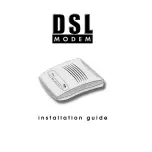
7
3
Connecting the DSL Modem to the Splitter
3.1 Overview
Note:
The procedures in Section 3 only apply to those customers who
choose to wire their own splitter-to-modem connection. If a certified
technican is performing the wiring, then proceed to Section 4 Turn-Up
and Operation.
The network interface device (NID) is typically located on the outside
of the customer premises. Certain installations, such as those at an
apartment complex, require the splitter to be installed closer to the
DSL Modem. The telephone or ADSL service provider also installs
this type of splitter.
Note:
The telephone service provider will install a splitter in the
network interface device (NID) to separate the voice and data interior
wire paths.
Before connecting the wires from the NID to the DSL Modem, verify
that the inside wire pair serving the DSL Modem has an isolated
path from the NID to the modem. Do not connect a telephone to the
same wire pair. In some instances, it may be necessary to reroute the
inside wire away from noise sources such as appliances, fluorescent
lighting, televisions, light dimmers, and other electrical noise
sources. It is recommended that the modem has dedicated inside
wiring.
For the DSL Modem, you will only need to connect the wires
associated with data output on the NID. The telephone company
technician has already connected the voice (or telephone) wiring. The
data module provides a connection point for the inside wire pair
serving the DSL Modem.
Note:
Category 3 (CAT 3) or Category 5 (CAT 5) twisted-pair wire is
recommended.
For inside wiring procedures see Section 3.2 before you start.










































